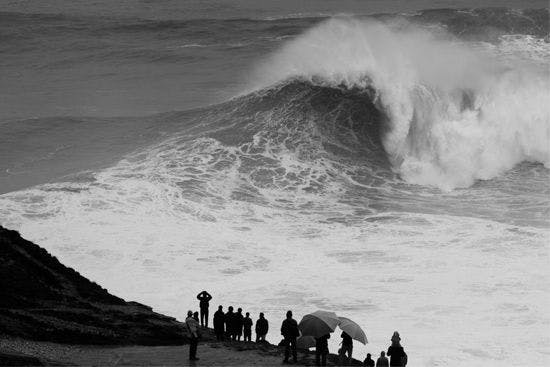Surf culture, Surf PhotographyThe Riders of the North Canyon

Words and images by Mat Arney.
Everybody loves a good lighthouse. And, with the higher latitudes of the Northern Hemisphere having a massive meteorological sneezing fit over the past few days and sending significant swells southwards, one of big wave surfing’s newest poster boys is back in the spotlight.
Nazaré seems to push its way to the front of each new huge swell event for a number of reasons: the first is that it has a 16th century fortress and lighthouse standing on the cliffs above it that instantly provides a picturesque reference point for the size of the waves breaking beneath it (when there is no surfer or jetski in the frame); it’s also easy for spectators to get to and gain a good vantage point on the action unfolding below; finally, it’s one of the western-most points of mainland Europe so swells reach it relatively unhindered and, because of how far south Nazaré is, the swells are often more organised and less wind-affected than at spots closer to the source storms further north. All of these mean that, whilst huge waves are being ridden at locations across Europe during each “code-black” swell, it is images from Nazaré that often make headlines.
Nazaré, however, is a big wave location that often causes some controversy concerning wave size. There is a good argument that when you stop quoting wave size in single figure increments and have to start using a range where the grey zone is larger than the waves that most surfers regularly ride (“it’s 50-60ft” for example), then us layfolk should just leave it at “big is big”, and let the XXL judges debate the finer points of wave face measurement.

But, why the debate? Well, unlike the majority of big wave spots where waves break over a reef, the waves that break off Praia do Norte are funnelled shoreward by the incredibly deep Nazaré Canyon, the deepest underwater ravine in Europe, before reaching the canyon’s headwall less than a kilometer from the coast where the depth decreases significantly; Praia do Norte is essentially a massive, shifting, beach break on the inside. From what is understood so far of the factors affecting the waves here, if swell direction is directly west then waves break with steeper faces whilst north westerly swells are subject to more “constructive interference” from the canyon that results in overlapping waves, increasing their height whilst often decreasing their gradient and causing the peak to shift.
The fact that the line-up is so dynamic and that few two waves break the same at Nazare makes measuring them accurately a difficult task. Some waves ridden there break top-to-bottom whilst others have a more gradual slope on the face which, thanks to the predominantly front-on view from the lighthouse, makes the greater distance between the peak and trough on a less-steep wave appear as a wave of much greater height. Taking a photo of a surfer on a giant wave, guestimating the surfer’s height and then multiplying this to find the distance between the peak and where you suppose the bottom of the wave to be (another moot point) will no longer suffice when there is reputation (and XXL Award prize money) at stake.
Regardless of exactly how big the waves ridden at Nazaré were yesterday, they were still enormous. Just like the waves ridden at the ASP Big Wave World Tour event at Punta Galea, Spain, or at Peahi (Jaws) on Maui, Hawaii over the last few days, they require the sort of skill, knowledge and courage that few surfers possess. Those who do venture out to prove themselves in such waves of consequence, whether in front of the cameras at Nazaré and Peahi, the judges at Punta Galea, or at a spot far from any spectators, should be applauded for being the brave pioneers that they are.